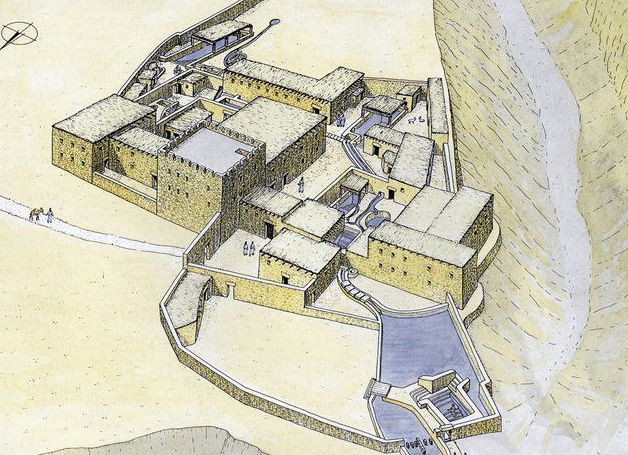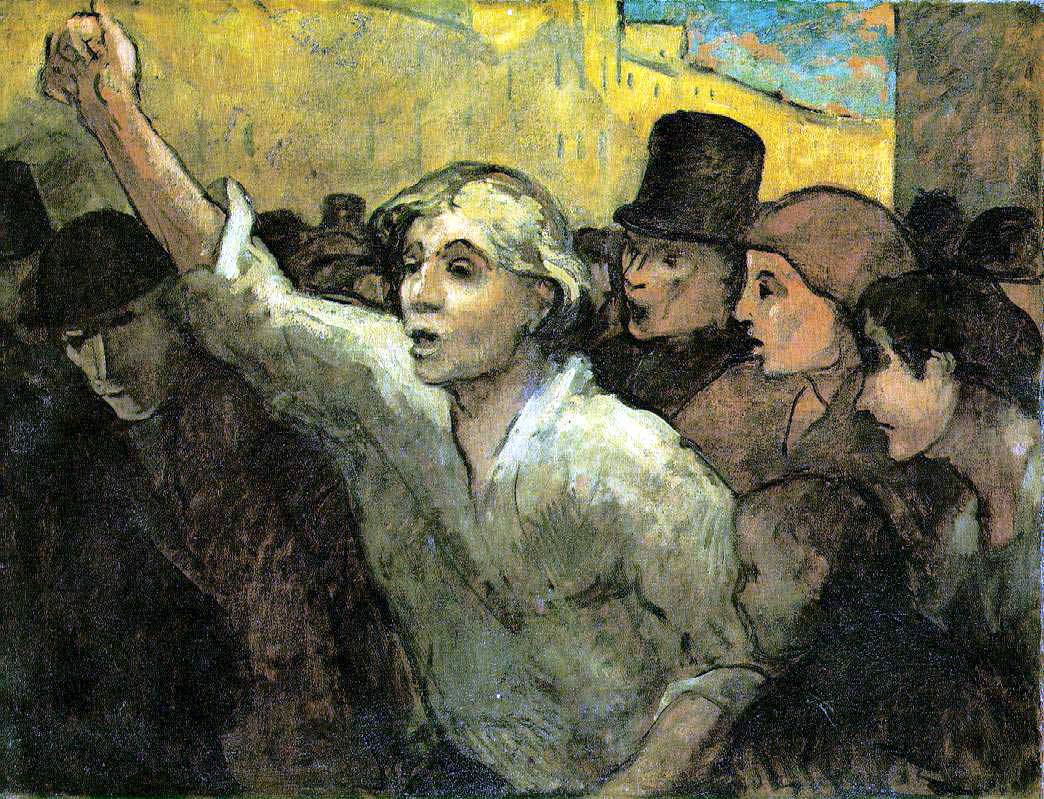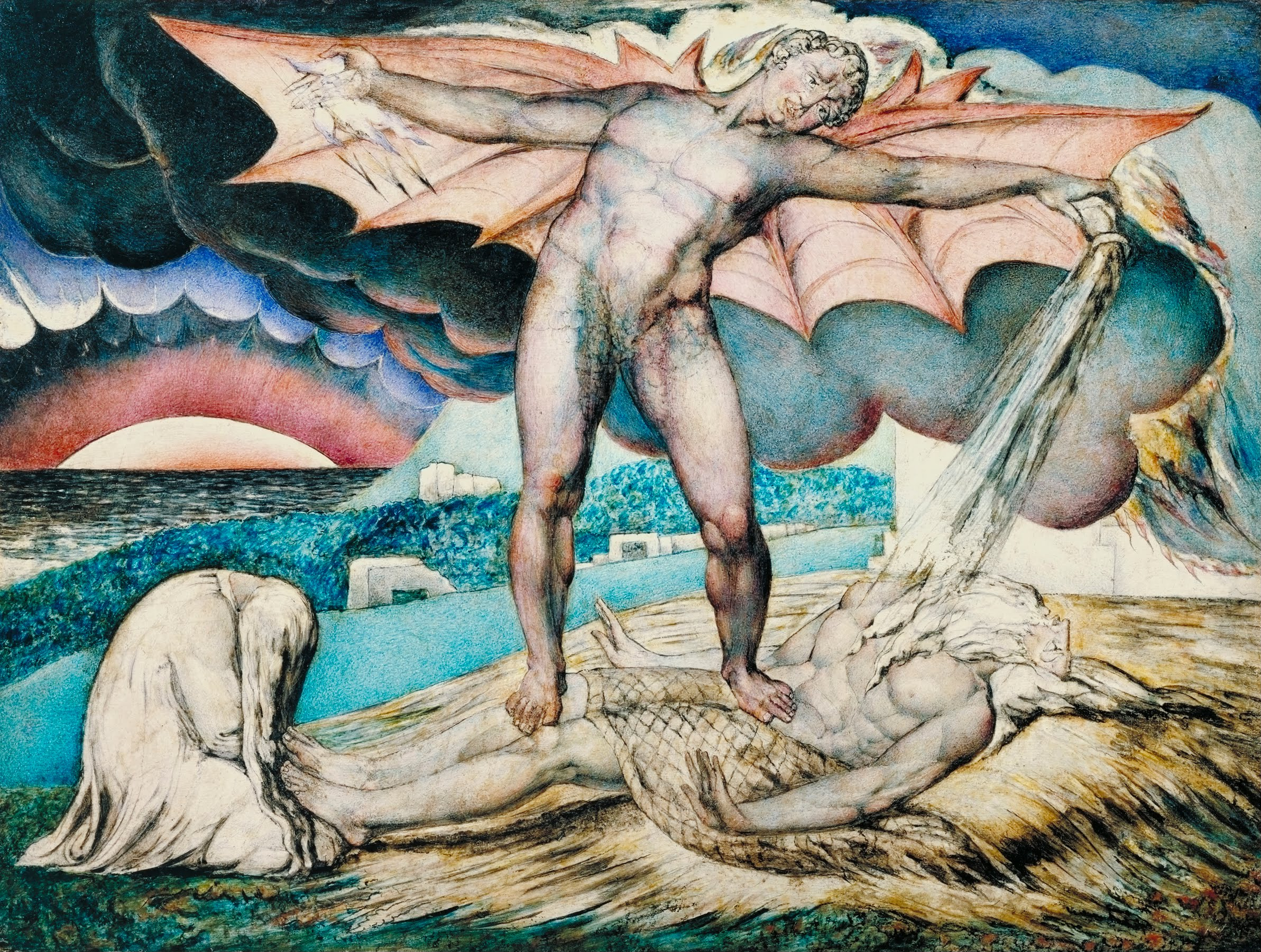Foregrounding the Problem
In his 1975 work Discipline and Punish, Michel Foucault uses the lens of prison and society to examine the ways in which power structures act upon the individual. He maintains that the power and techniques of punishment depend on knowledge which, in turn, creates and categorizes individuals. He also proposes that knowledge derives its authority from the relationship between the exercise of power and systems of discipline. Thus power authorizes knowledge and knowledge directs power. He demonstrates this through tracing the soul’s gradual replacement of the body as the focus of punishment and reform in eighteenth century French society.[1]
The community at Qumran, believing they possessed special knowledge that classified them alone as holy[2], derived their authority from God [3]as He revealed Himself in their scriptures and to the teacher of righteousness. This divine[4] anointing of the community at Qumran gave them the authority to stringently punish members of their community who violated their many and varied precepts – with the most frequently prescribed punishments as some form of exclusion or expulsion from the community, temporary or permanent, in order to insure that none of the Sons of Darkness hid amongst them. These ordinances and many other details of daily life at Qumran are outlined in a text known as the Community Rule.
Foucault’s Discipline and Punish “serves as a historical background to various studies of the power of normalization and the formation of knowledge in modern society”[5] and as such, has the capacity to illuminate the ways in which power manifested itself in the Qumran community. In applying Foucault’s foci of body and soul to the punishments of exclusion and expulsion outlined in the Community Rule, scholars may reasonably draw the conclusion that the religious nature of the power structures in place caused the Qumran community to function as reformers through their methods of punishment.
The scrolls found in the caves bordering the Dead Sea have a direct tie to the community which existed in the compound 300 feet below. The archaeological evidence found in both places (jars, inkwells, pottery shards) as well as the reconstructed timelines of the individual sites in addition to their close proximity of less than two miles apart indicates an affiliation between the caves at Qumran and the compound below.[6] In light of this evidence it will, as we shall see, be possible to apply Foucault to the Community Rule, but also apply Foucault to the Qumran community via the Community Rule.
A second assumption we need to make here is methodological. We assume that the application of modern philosophy to ancient texts is appropriate. That is a sometimes highly contested position to take. However, while ancient peoples would not have conceived of punishment in the way in which Foucault does, that does not invalidate his philosophy as a lens through which to examine them. As modern scholarship is undertaken by modern scholars, we need not limit ourselves to the resources or thought patterns that ancient peoples employed.
Foucault makes certain to ground his discourse on power and knowledge squarely within the context of eighteenth century French prison systems. We can, therefore, place the Community Rule[7] within Foucault’s discourse on power by aligning it with a line of objectification he attributes to eighteenth century reformers. This essay in no way suggests that either community directly act upon each other in any capacity, but rather suggests that both serve as case studies for the same phenomenon of power.
Power and Punishment
According to Foucault, “there is no power relation without the correlative constitution of a field of knowledge, nor any knowledge that does not presuppose and constitute at the same time power relations”[8]. For Foucault, knowledge and power intertwine indivisibly.
The Community Rule depicts the ways in which the community at Qumran predicated themselves upon a 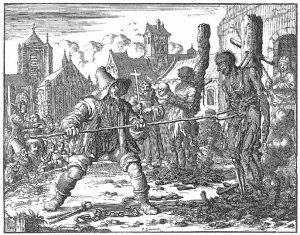 possession of special knowledge of/from God. They believed “From the knowledge of God stems all there is and all there shall be. Before they existed he established their entire design.”(3.15). They themselves, as part of “all there is”, come from the knowledge of God. They centered their blessings around said knowledge – “May he illuminate your heart with the discernment of life and grace you with eternal knowledge” (2.3) and expected their members to “…comply with all revealed things” (1.9-11), demonstrating their view of their law as divinely inspired.
possession of special knowledge of/from God. They believed “From the knowledge of God stems all there is and all there shall be. Before they existed he established their entire design.”(3.15). They themselves, as part of “all there is”, come from the knowledge of God. They centered their blessings around said knowledge – “May he illuminate your heart with the discernment of life and grace you with eternal knowledge” (2.3) and expected their members to “…comply with all revealed things” (1.9-11), demonstrating their view of their law as divinely inspired.
Their lives were to exhibit “a spirit of knowledge in all the plans of action,…of careful behaviour in wisdom concerning everything, or concealment concerning the truth of the mysteries of knowledge.”(4.6), and from their knowledge, they derived their eschatology – “God, in the mysteries of his knowledge and in the wisdom of his glory, has determined an end to the existence of injustice and on the appointed time of the visitation he will obliterate it forever.” (4:18-20) Assuming themselves privy to the mysteries of God’s knowledge, which they derived from interpreting their scriptures, the community at Qumran believed that they lived in the end days. The community at Qumran clearly conceived of their entire structure as divinely ordained.
The Community Rule lists numerous, meticulous and slightly humorous ordinances such as not permitting “sleeping in the session of the Many” (7.10), “walking around naked unnecessarily” (7.12) and “giggling inanely” (7.14). It does not, however, elaborate on the nature of many of the punishments. The Hebrew word used throughout the Community Rule simply means “punish”. Out of the nine punishments which it does specify, the primary methods of punishment included exclusion in some capacity, or expulsion.
The community at Qumran could exclude one of their members for knowingly lying about possessions (6.24-25), speaking the Name[9] (6.27b-7.2), speaking angrily against one of the priests enrolled in the book (7.3), knowingly and without reason insulting his fellow (7.4), defaming his fellow (7.15,16), turning aside from the foundation of the community to betray the truth and walk in stubbornness of heart (7.18-22), and doing the same after participating in the community council for ten full years (7.22-24).[10] The Community Rule lists only two offenses, however, that result in complete expulsion: “whoever goes round defaming the Many shall be expelled from their midst and never return” (1.16) and “whoever complains against the foundation of the community shall be expelled and will not return” (1.16).
The distinction between the two categories of offenses stems from a theological understanding. The Qumran community understood the first group, those punished with exclusion, as “Sons of Light” whose spirits deviated and, misled by the Angel of Darkness, offended unintentionally and may expiate their sins through a temporary exclusion from certain aspects of the community. The “Sons of Darkness”, on the other hand, as deceivers who never belonged among the people at Qumran, required excision from their midst.[11]
Foucault’s reformers “proposed a whole panoply of penalties that were natural by institution and which represented in their form the content of the crime” such as Vermeil who suggested abuse of liberty punished by deprivation of liberty, theft punished by confiscation, and murder punished by death.[12] The community at Qumran punished similarly, but in a much broader manner. The community excluded its rightful members for a time, treating them as if they did not belong because they had behaved as though they did not belong. Similarly, the community expelled those who sinned against them in such a way that made evident their status as “Sons of Darkness” – permanently removing those who should never have been. These specific punishments were drawn from Deuteronomy 29-30 and Numbers 15, in which the Biblical writers discuss the renewal of the covenant and the stoning of the Sabbath breaker respectively[13].
Effects of Exclusion and Expulsion on Body and Soul
Many scholars[14] affiliate the community at Qumran with a sect[15] of Jews called the Essenes. Pliny the Elder, Josephus, and Philo identified the location of the Essenes as on the Western shore of the Dead Sea and gave descriptions of practices and theology, such as the forfeiting of personal property and a heavy reliance on fate, which match with the location and descriptions of practices and theology in the Dead Sea scrolls[16].[17] The Essenes believed in resurrection of both body and soul[18] which, assuming the Qumran community consisted of Essenes[19], would have informed the ways in which they treated body and soul in punishment.
Exclusion and the Body
The punishment of exclusion acted upon the body in the most literal sense by keeping it from entering certain spaces. In one specific punishment, The Community Rule references reductions of rations as recompense. But there are no gruesome, public or bloody punishments prescribed in the Community Rule such as Foucault describes as having occurred in 18th century France, due to their fundamentally different
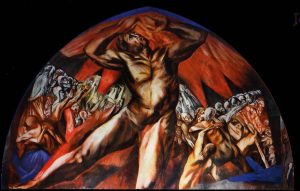
purposes.
The drawing and quarterings, hangings, and decapitations which Foucault depicts as very public spectacles, the executed often left for days as an example to the public, exemplified the fulfillment of monarchical law; where punishment as a ceremony of sovereignty uses terror to display power.[20] “The reforming jurists, on the other hand, saw punishment as a procedure for requalifying individuals as subjects”[21], mirroring the intent of the punishment of exclusion on the body by the community at Qumran.
Section 7.18-22 of the Community Rule gives the best example of the community at Qumran’s use of expulsion of the body as redemptive.
The person whose spirit turns aside from the foundation of the community to betray the truth and walk in stubbornness of his heart, if he comes back, shall be punished for two years; during the first year he shall not approach the pure food of the Many… and during the second year he shall not approach the pure food/the drink/ of the Many and shall sit in the back of all the men of the Community. When the days of the two years are complete, the Many shall be questioned concerning his affairs; if they admit him, he shall be enrolled in his rank; and later he will be questioned in connection with judgment…
In this specific example, a member of the community has left and desires to return. But they must first go through a two year process, the first year in which they do not participate in the pure food of the Many and they second year in which they additionally sit in the back of all the men of the Community. After this time the community questions the Many, who have supervised the individual, and then the individual him/herself, presumably because this two year period serves as an indicator as to whether or not the individual who left has earned reinstatement. This two year period can “requalify the individual” as a member of the Community.
While the body is acted upon, permitted and disallowed from different spaces based upon the actions of the individual, the body itself is never directly physically harmed;[22] this most likely due to the importance the community at Qumran attributed to the flesh. By the physical attributes of the individual the community determined their status in the community.[23] Additionally, because they believed in bodily resurrection of the dead, the body remaining unharmed in restorative punishments would have had importance.
Blasphemy/rebellion, the most severe crime that one could commit against the community, identified individuals as Sons of Darkness. Expulsion punished said offense. As their most severe punishment inflicted no direct violence to the flesh, that lesser crimes would not have punished thusly. In second temple Judaism(s), Jews predominantly made restitution for their crimes via fines and sacrifices – but as an individual in the Qumran community possessed little to no property of their own, they sacrificed themselves via exclusion until they achieved propitiation, serving as the scapegoat for themselves.
This requalifying/redemptive nature of the punishments at Qumran likens them to Foucault’s concept of docile bodies. Only Qumran disciplined the spirit (through the body) so as to move the body to right action, as opposed to disciplining the body for the same purpose. Exclusion of the body functioned more as a discipline than a punishment.
Exclusion and the Soul
As Foucault writes, “the expiation that once rained down upon the body must be replaced by a punishment that acts in depth on the heart, the thoughts, the will, the inclinations. Mably formulated the principle once and for all: ‘Punishment, if I may so put it, should strike at the soul rather than the body’.” [24] 6.24-25 states that “if someone is found among them who lies knowingly about property, he shall be excluded from the pure food of the Many for a year and they shall withhold a quarter of his bread.”
While including an obvious physical component, this passage indicates that the pure food of the Many was not the only food source for an individual at Qumran (even after exclusion from the pure food, they withhold additional food), which then indicates the removal of food was not the primary focus of this punishment. Instead, the punishment focused on exclusion from participation in the pure food of the Many – denying access to a communal space/ceremony.
In the context of the Second Temple period it is almost impossible to overstate the significance of table-fellowship in Judaism(s). As Jerome Neyrey argues, “food, articulated in terms of who eats what with

whom under which circumstances, had long been one of the most important languages in which Jews conceived and conducted social relations among human beings and between human beings and God.”[25]
The most likely interpretation for the necessitation of exclusion here is that the touch of the excluded member would cause defilement of the food – while the consumption, on his own, of his own rations poses no such threat.[26] This punishment severed the individual from an important component of communal life, marking their relationships with both God and the community as strained. During the Second-Temple Period, the soul as the life force which caused an individual’s ability to exist started to develop as a central focus of Judaism(s). This judgment and separation would have induced great remorse and shame, as redemption of the soul necessitated.[27]
Expulsion
Expulsion from the Qumran community equated death for both body and soul. After having lived with the community at Qumran, the expelled individual would have minimal to no personal property. All of their belongings and financial resources would be lost to them. Left in the middle of the desert with no money and no food, they would be at the mercy of bandits, wild animals, and heat. Having rejected and damned all those in their previous life, they would have had no community to return to.
Expulsion also would have meant damnation of the soul. Expulsion from the community meant expulsion from the Children of the Light upon whom God had special favor. And anyone not of the Light, in their dualistic mindset, must therefore have been of the Darkness. There was no grey area except Sheol, the place of shadows, which previously unencumbered by connotations of either the positive or negative variety begins to take on a sinister vibe in the Dead Sea Scrolls.
Expulsion from the community at Qumran served a purpose, not only to punish the offender, but also to protect the faithful. The use of the term ביד דמה with its contrasted punishments indicates that the author of 6.14-23 had a specific passage of the Torah in mind, namely, Numbers 15: 30-31 which reads “ But whoever acts high-handedly, whether a native or an alien, affronts the Lord, and shall be cut off from among the people. Because of having despised the word of the Lord and broken his commandment, such a person shall be utterly cut off and bear the guilt.” (NRSV).[28]
Interestingly, this particular passage follows the prescription of a sacrificial goat for unintentional sin. For the community at Qumran, it seems, that the expelled individual takes the place of another goat – the scapegoat mentioned in Leviticus 16. When the expelled individual leaves the camp (s)he takes with her/his sins with her/him – distancing the community from impunity.
In the logic of the reformers, what harm you cause is caused to you – and here is the most clear evidence that the community at Qumran functioned similarly. If an individual willfully brought sin into the camp, they were expelled – taking it with them as they left. As it the scapegoat dies in the desert, so was that a likely possibility for those expelled from Qumran.
Conclusion
While exclusion meant extreme physical and emotional discomfort, expulsion meant death – both physically and spiritually. This punishment’s idea was such that it “robbed forever the idea of crime (sin) of any attraction”[29] for the community at Qumran.
Foucault uses the history of the French prison system to assert the indivisibility of knowledge and power with institution. The reformers, working within an institutional framework of power were not solely idealists, and the community at Qumran, working within an institutional (R)religious framework of power were not either. No individual who takes on the role of “punisher” is ever again truly innocent.
“But a punishment like forced labour or even imprisonment – mere loss of liberty – has never functioned without a certain additional element of punishment that certainly concerns the body itself: rationing of food, sexual deprivation, corporal punishment, solitary confinement … There remains, therefore, a trace of ‘torture’ in the modern mechanisms of criminal justice – a trace that has not been entirely overcome, but which is enveloped, increasingly, by the non-corporeal nature of the penal system.”[30]
Rebekah Gordon is a graduate in the Religious Studies department at the University of Denver. She is a poet and a musician in addition to an academic, and is an editor for the e-mag Esthesis as well as an assistant editor for The Journal for Cultural and Religious Theory. Her interests range from secular-sacred relations in America to religious fiction, semiotics, and redemption theology.
________________________________________________________________________
[1] Foucault, Michel. Discipline and Punish: The Birth of the Prison. (New York: Vintage Books, 1995.)
[2] Martinez, Florentino Garcia and Eibert J.C. Tigchelaar, ed., The Dead Sea Scrolls Study Edition, Vol. 1 (1Qs) (Grand Rapids: William Eerdmans Publishing Company, 1998), 69-99.
[3] All references to God refer to the Hebrew God, Yahweh. As a proper noun, it will be capitalized.
[4] In an attempt to cover all possible conceptions of generic, ill-defined terms such as “divine”, “religion”, “worship” etc. each will be parenthetically capitalized and pluralized. Idea adapted from Madison Tarleton, University of Denver.
[5] Foucault, 308.
[6] VanderKam, James C., and Peter W. Flint. The Meaning of the Dead Sea Scrolls: Their Significance for Understanding the Bible, Judaism, Jesus, and Christianity. (San Francisco, CA: HarperSanFrancisco, 2002), 34-54.
[7] It is also worth noting that when this paper refers to the Community Rule, it refers specifically to 1QS, not 4QSb,d and 4QSe – as these Serekh textual traditions, while similar enough to suggest a common source with 1QS, differentiate enough to suggest that they most likely developed for different audiences, than the community at Qumran.
Alison Schofield, Reading Between the Versions: Community and Identity in the Qumran Community Rule. (Ann Arbor, MI: UMI Dissertation Publishing, 2012)
[8] Foucault, 27.
[9] שם – hashem, the name of God
[10] The offenses listed in 6.27b-7.2 and 7.22-24 are actually punished with expulsion, but from the community council, not the community as a whole. As the community council was only one component of the community (8.1), I placed it under the exclusion category, as to allow the category of expulsion to stand for expulsion from the community in its entirety.
[11] Shemesh, Aharon. “Dead Sea Discoveries Style.” Dead Sea Discoveries 9, no. 1 (2002): 63. doi:10.1163/156851794×00239.
[12] Foucault, 105.
[13] Shemesh, Aharon. “Dead Sea Discoveries Style.” Dead Sea Discoveries 9, no. 1 (2002): 60. doi:10.1163/156851794×00239.
[14] VanderKam The Meaning of the Dead Sea Scrolls, Scofield From Qumran to the Yahad, De Vaux Archaeology and the Dead Sea Scrolls
[15] Though, at the time of the second temple there was no normative Judaism, thus problematizing the term “sect”.
[16] Specifically the Community Rule.
[17] VanderKam, 240-243.
[18] Vermès, Géza, and Martin Goodman. The Essenes: According to the Classical Sources. (Sheffield: Published on Behalf of the Oxford Centre for Postgraduate Hebrew Studies by JSOT Press, 1989,) 73.
[19] And I do.
[20] Foucault, 130.
[21] Ibid.
[22]As far as we can tell.
[23] As evidenced by in their physiognomic text which implies inscription of salvation in flesh.
[24] Foucault, 16.
[25]University of Notre Dame. Accessed November 01, 2016. https://www3.nd.edu/~jneyrey1/meals.html
[26] Oxford University. Accessed November 03, 2016. http://jts.oxfordjournals.org/content/63/1/49.full.pdf
(though this author does not tie the community rule to the community at qumran, that can be explained by Reading Between the Versions
[27] As was their goal, which was discussed in the previous segment on the body.
[28] Shemesh, Aharon. “Dead Sea Discoveries Style.” Dead Sea Discoveries 9, no. 1 (2002): 60. doi:10.1163/156851794×00239.
[29] Foucault, 104.
[30] Foucault, 15.
